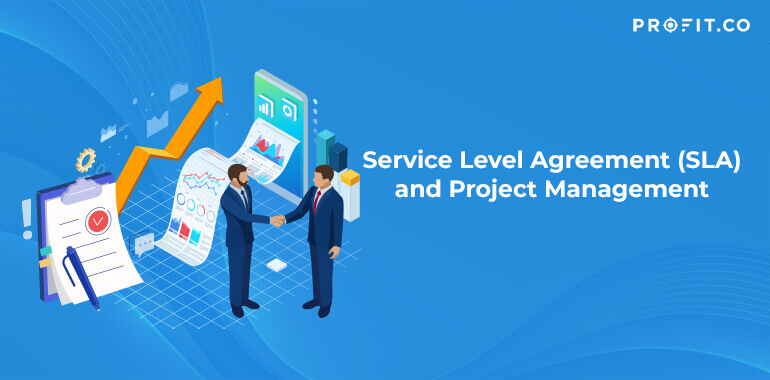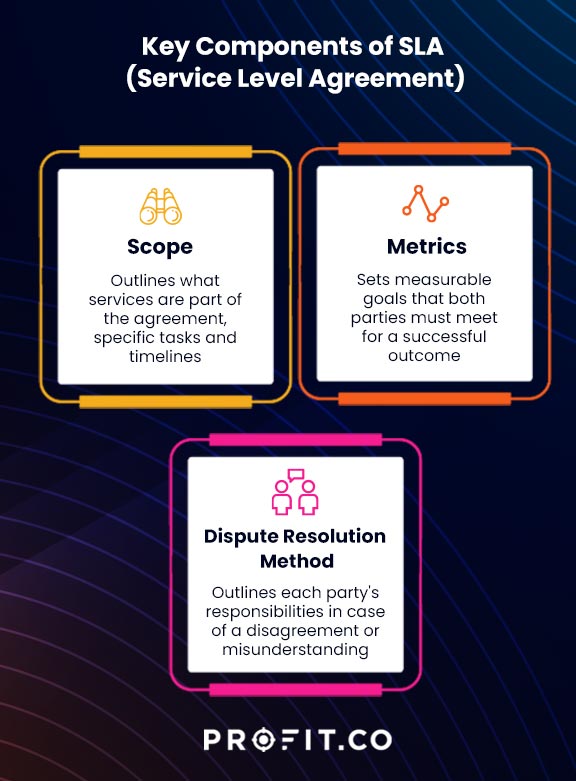No matter your business type, having an effective Service Level Agreement (SLA) is essential for successfully managing projects. An SLA can clarify payment terms and deadlines with the proper setup. It also helps to ensure both parties meet everyone’s expectations throughout each stage of project management.
Having a well-written document in place is essential if you plan on using external vendors. Let’s discuss SLAs, why they are important, who needs one, the key components, and the different types of SLAs.
What is Service Level Agreement?
The SLA is an agreement between two parties, a vendor and a customer. The agreement outlines the expectations of service quality.
It’s essential to have an SLA in place when managing projects as it defines the delivery terms. The SLA may include specific requirements for performance metrics such as response time or availability. Therefore, you can monitor how well your organization is meeting its commitments.
Why Do You Need a Service Level Agreement?
A Service Level Agreement (SLA) is essential in project management to ensure successful outcomes and is vital to building a competitive business. They provide satisfied customers, an excellent reputation, and enable professional services.
SLAs help clarify deliverables, payment terms, dispute resolution methods, and other essential factors you need to consider when managing projects.
Additionally, an SLA can help reduce disputes over fees or other issues related to project management by providing clear guidelines for resolution. Having an SLA before starting a project can avoid scope creep in project management leading to costly miscommunications or disputes.
Who Needs a Service Level Agreement?
Regarding SLA in project management, any business or organization relying on a vendor for services will need an SLA. You must have an SLA beforehand to utilize external vendors for specific tasks or services related to your project management plan.
This document allows all stakeholders to measure performance against agreed-upon metrics, and you can accurately track progress throughout the project. All Organizations need an SLA.
All organizations need agile OKR software to ensure all their projects can be tracked and improved. Book a free demo with our team to learn more about how OKR software can optimize your organization’s performance!
Service Level Agreement
The SLA for project management, ensures both parties understand each other’s roles and responsibilities and defines what constitutes good performance from either side.
Key Components of SLA
- Scope
One of the critical components of an SLA is the scope. This section outlines exactly what services are part of the agreement, such as specific tasks, requirements, or timelines. Getting this right is essential so both parties know what to deliver and when.
- Metrics
This part of the SLA defines how you will measure success. It sets measurable goals that both parties must meet for a successful outcome.
- Dispute Resolution Methods
This clause outlines each party’s responsibilities in case of a disagreement or misunderstanding about something within the agreement.
Disputes could arise from disagreements over fees or timeline changes. Having an established process helps ensure that everyone knows their rights and obligations. Setting clear guidelines also helps reduce potential conflicts, which can become costly if not handled properly.
unless both sides win no agreement can be permanent
Types of SLAs
There are three primary Service Level Agreements (SLA) categories:
- Service-based SLA
These agreements exist between customers and service providers. The details depend on the services the customer gets from the provider. For instance, in an SLA template, the provider may offer a customer a service package that includes routine maintenance and email systems.
- Customer-based SLA
These SLAs are between individual customer groups and service providers. In a Service Level Agreement example, the finance department in a company may comprise a customer group. The customer-based SLA, in this case, can mandate the service provider to manage the following:
- Procurement systems
- Payroll
- Billing
- Financial Software
- Multi-level SLA
These types of SLAs fall under three sub-categories. Each sub-category applies similar services to various customer groups with the same SLA.
- Corporate-level SLA
This tier offers SLA management for all individual users within the customer organization. Most issues this level deals with are non-critical, and SLA performance updates and reviews are, therefore, less frequent.
- Customer-level SLA
This tier offers SLA management for particular customer groups. However, it applies to all services in use or offered by the provider.
- Service-level SLA
This tier offers SLA management for services linked to specific customer groups.
SLA Metrics
When it comes to Service Level Agreement (SLA) metrics, they are essential for measuring the performance of any project. These metrics provide clear and measurable goals that both parties can use to track progress throughout each project stage.
Typically, SLA metrics include:
- Turnaround Time (TAT) – This metric refers to the time necessary to handle a specific task or address an issue once it reaches the service provider.
- Uptime or Availability – This metric, also known as system reliability, measures the time a device or system remains functional. It’s also the time when provided services are accessible to the customer.
- Mean Time to Recovery (MTTR) – This metric involves recovery time after a service outage.
- Business Results – This involves using key performance indicators to determine how the service providers’ contributions impact the business performance.
- Defect Rate – This metric represents the error percentage in deliverables. It can cover any aspect, such as missed deadlines or coding errors.
A well-defined set of metrics helps ensure everyone is accountable for their commitments. It provides clarity around what constitutes good performance from either side.
How to Set SLAs to Measure Performance
When setting Service Level Agreements (SLAs) to measure performance, the key is having a clear set of measurable goals and objectives. This means outlining specific metrics you must meet for a successful outcome, such as response times, availability rates, customer satisfaction scores, etc. Additionally, ensuring dispute resolution methods are in place can help reduce potential conflicts, which could become costly. Considering customer satisfaction clauses in your SLA may also be beneficial. This allows everyone to feel comfortable knowing the other party will meet expectations.
Ultimately, having an effective setup before any project can help avoid miscommunications or disagreements. It also measures success accurately against pre-defined goals!
Best Practices
When it comes to SLA best practices, the key is having a clear set of measurable goals and objectives.
First, ensuring the SLAs are clear, without any complex language, is essential. It enables all involved parties to understand the agreement and their responsibilities. Next, you should clearly define the methods and processes you’ll use to compensate, enforce and measure service levels.
Additionally, instead of having one complex SLA, it’s best to break it down into smaller SLAs you can easily report on and measure.
FAQs
- What is an SLA?
An agreement between two parties (usually a business or a customer) that outlines each party’s services, requirements, expectations, and responsibilities.
- What are the benefits of having an SLA?
Having an SLA helps ensure that all involved parties understand their roles and responsibilities regarding the project. It also ensures that you set measurable goals to track performance accurately throughout the project.
- What should be in an SLA?
When creating an SLA, make sure to include components such as
- The scope of services
- Performance metrics
- Dispute resolution methods
- Customer satisfaction clauses
Conclusion
Service Level Agreements (SLAs) are essential for any organization to provide a service consistently without compromising on quality. All stakeholders need an SLA on which to base their expectations and agreements. It can be two businesses dealing between them or a service provider’s terms of use with its customers.
The agreement is only as good as the service’s speed, quality, and reliability, so the SLA should have the proper components. Additionally, you must have metrics to measure performance. This ensures that those adhering to the agreement remain accountable for delivering the product or service effectively. Following best practices when creating an SLA will help ensure that all parties remain satisfied with the result.
The OKR framework has been instrumental in the success of some of the giant conglomerates of our times and has helped in successful project implementation. The framework helps us track our goals with metric-driven key results. Along With SLA for agile project management, you can get started on Profit.co completely free today!





